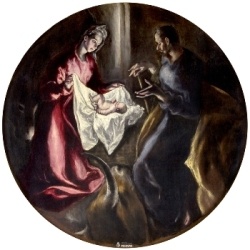Christmas & New Year customs applied on exquisite specimens of Greek art
The most festive and joyful time of the year has come and cities across Greece are beautifully decorated for Christmas and the New Year. Houses, commercial shops and central squares are decorated with Christmas trees and the traditional Christmas boats and the streets are full of people of all ages who are shopping and are eagerly getting ready to celebrate in the best possible way before the turn of the year. During those festive days of Christmas there is a great number of customs and traditions visible across the country which, in fact, derive from far back in time. Let’s have a look at how the Christmas & New Year local customs are applied on exquisite specimens of Greek art...
Decoration of the Christmas tree...
The decoration of the Christmas tree has its roots in antiquity. The ancient Greeks decorated olive or laurel branches with red and white woolen ribbons and hanged various sweets in order to thank the gods for the year’s good crop and seek a favourable one for the next year.
Nowadays, in most Greek households the decoration of the fir Christmas tree is commonplace. A custom which was initiated by Greece’s first king, Othonas and which children await with great anticipation every year. Below, the painting by Spiros Vikatos titled "Christmas Tree", hosted in the National Gallery of Athens.
/christmas-tree_Spyros%20Vikatos_510_375.jpeg)
The Christmas tree - Spyros Vikatos - oil on canvas
...or the Christmas boat?
Greece is a country with a glorious naval history and cherishing a great relation to the sea since forever, therefore, the habit of decorating boats instead of trees - especially on the Greek islands - is very common. Central squares of cities and villages near the sea, are usually decorated with the Christmas boat, such as the co-capital of Greece, the city of Thessaloniki which always decorates a massive Christmas boat in central Aristotelous square.
Christmas Greek carols
Christmas and New Year in Greece, mean wishing to each other through joyful melodies too! The Greek Christmas carols are usually sung by young children on Christmas Eve, New Year Eve and the Epiphany when they will go from neighborhood to neighborhood and door to door holding iron triangles and small drums or even a harmonica or accordion to sing their wishes and earn either money or treats from doing so. The most famous Greek painting depicting the festive custom of caroling with such unique simplicity and sensitivity, is that of painter Nikiforos Litras titled “The Christmas Carols”.
/Carols_Lytras_Nikiforos_510_342.jpeg)
The Christmas Carols - Nikiforos Litras - oil on canvas
Pomegranate for good luck
A symbol of good luck, abundance, youth and fertility since the ancient times. The pomegranate is one of the most beneficial fruit to the human in more than one ways and has inspired many artists, such as George Iakovidis in his painting “Pomegranates”. Nowadays, the landlord of the household breaks a pomegranate on New Year’s day at the front door for good luck and health.
/Iakovidis_rodi_510.jpg)
Pomegranates - George Iakovidis - oil on canvas
Naughty Christmas Goblins
/kalikatzaroi_tetsis_250.jpg) They come down the chimney attracted by the mouthwatering culinary delights prepared by the lady of the household. They are ugly, they are naughty and their only aim is to cause trouble to your household...Apparently, Santa Claus is not the only one coming down your chimney during the Twelve Days of Christmas.
They come down the chimney attracted by the mouthwatering culinary delights prepared by the lady of the household. They are ugly, they are naughty and their only aim is to cause trouble to your household...Apparently, Santa Claus is not the only one coming down your chimney during the Twelve Days of Christmas.
The uninvited festive guests are goblin-like spirits according to Greek folklore and they slide into homes bearing trouble...and not presents! They are called the Kallikantzaroi goblins and if you want to keep them out just hang an onion on your front door! To find out more about them, just read the book by T. Veloudios, titled "Fairies, elves and goblins".
A spiritual celebration
The great Greek artist Domenikos Theotokopoulos, known as El Greco, captured through his painting "The birth of Jesus” all the spirituality and mysticism of the Greek Christmas.
Source: visitgreece.gr



